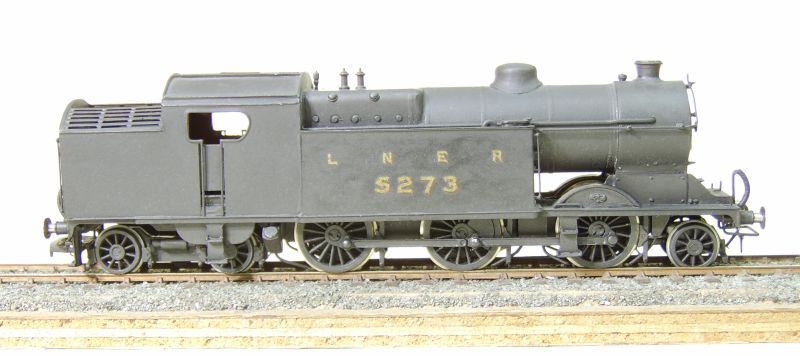On to the next project then.
Rebuilding some old clerestory carriages....
I built these late last year/ early this year and ended up with a set of five carriages, all looking like this:

Typically, no sooner had I finished them then I found a better way of representing the teak finish. I was also more than a little annoyed by the massive couplings on each carriage; leaving a 1.5-inch gap between each coach (put another way, this was a scale 8 feet. Put differently, it added six inches to the overall length of the train- the difference between 'just fits my space' and 'won't go'.)
Getting increasingly dissatisfied with the train set style couplings, I decided to experiment with alternatives. The clerestory rake became the guinea pig for testing ideas... the first idea was to make a simple 'hook and loop' from wire, but I found this too fragile and liable to distorting. The second attempt was to make my own three link couplings, and although these work and look good, I found them too finicky for everyday use (the main problem being the hieght of the carriage above the coupling- with small open wagons I see no problem). This left the buckeye coupling to try, so I bought some, fitted them to a few carriages and then (without sounding too childish) 'had a play'. I think that the coupling problem has been solved; they are quite small, they look good and they work.
The problem though is that to fit the couplings the bogies had to be removed. To remove the bogies I had to release a plastic lug inside the carriage. To get to this lug I had to wreck the interior I had fitted.... quite quickly the amount of work involved rose to the point where it would take just as much time and effort to completely rebuild the carriage as it would just to make good the damage done in fitting the new couplings.
So; let's pick up with the new couplings fitted and the interior in ruins. The first step is to remove the remains and discard them; this includes the glazing. The coach body is then given a coat of gloss yellow paint and set aside to dry. Once it has dried (this takes about a day), you can set-to with a pencil and ruler to measure up for a new interior.
I have decided in future that any interiors I fit to my carriage stock should be removeable. So the first stage of the interior is to measure the internal dimensions of the carriage for a false foor. This is then cut out of paper, and dropped inside to test the fit before we go any further. I found that although the carriage measured 28mm inside, ideally I needed an interior 2mm less than that to fit comfortably.
I then measured the individual compartments up and found they were 24mm (a scale 6 feet' each. Wanting to minimise the number of parts to the interior, I decided the best way of building it is from one continuous strip of paper. So you cut a strip of paper 26mm wide by 'however' long; 297mm in my case as I used some scrap A4 paper I have to hand. You then measure back 24mm along the length, and mark off. This gives you a floor. Then measure back 26mm and mark off, and then another 26mm and mark off again. Then another 24mm.... you repeat this for the number of compartments in the carriage. Then you score the mark lines and fold it up. The 24mm lengths are the floors for each compartment and the 26mm lengths become the bulkheads in between. This is then glued to the false floor and painted.

I had noted when I finished these carriages the first time that fitting an interior increased the realism of the model by stopping the capability of being able to see through it from end to end; at the same time however much of the effort was wasted as the seats were not visible unless you actually got up close and went looking for them. Therefore on these carriages I limited my interior to the floor and the bulkheads.
When you've built the interior, set it aside and bring the carriage body back. Now the 'fun' begins!
I painted the body in satin mid-brown paint and then removed most of it with tissue paper. What you end up with is a faint smear of brown paint, thin enough for the undercoat to show through in places. It looks remarkably like woodgrain. That's the teaking finished. Once it has dried I replaced the glazing and fitted my new interior, then repainted the roof.
So; the newly rebuilt carriage, now awaiting transfers and varnish:














